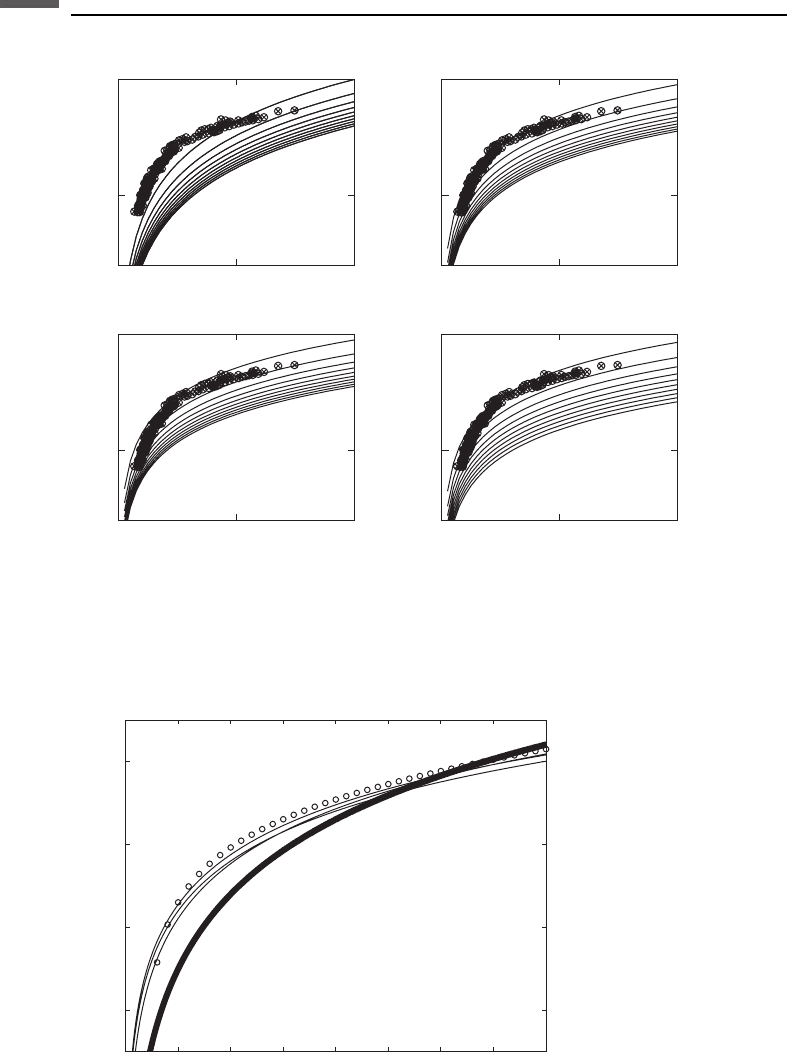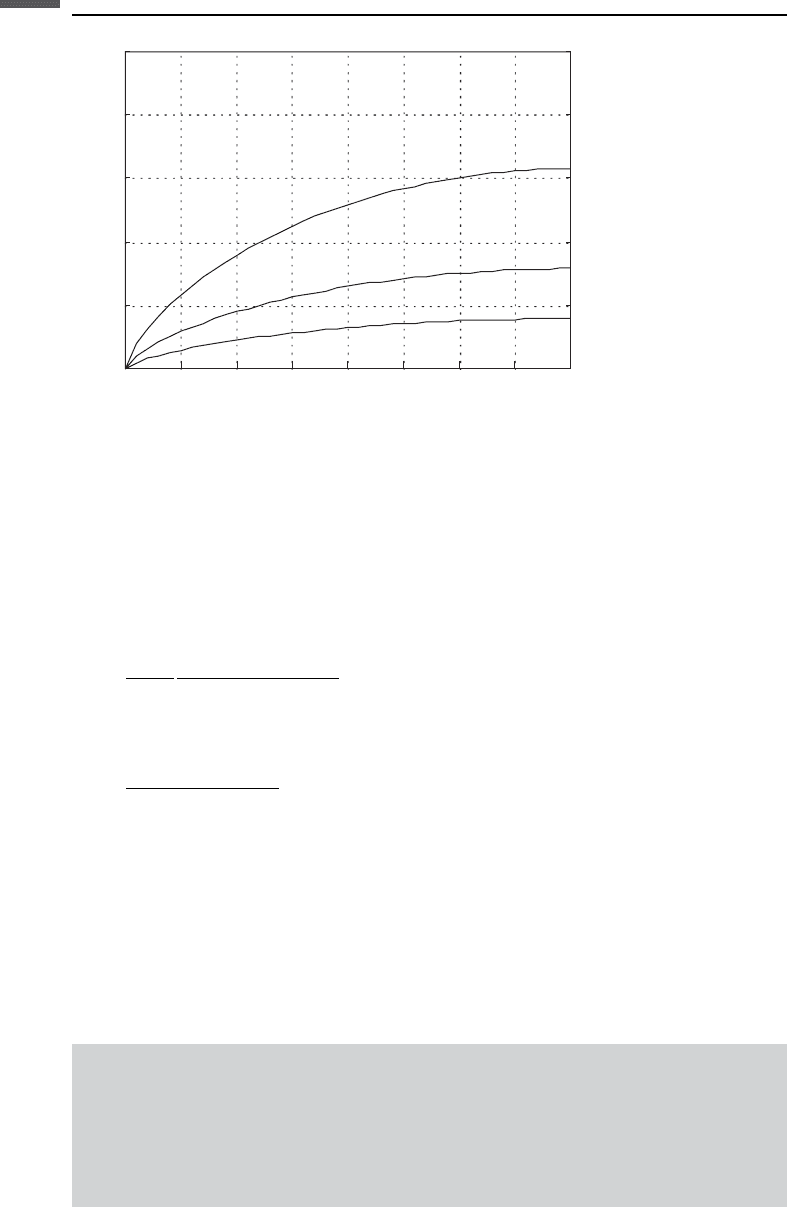Mavko G., Mukerji T., Dvorkin J. The Rock Physics Handbook
Подождите немного. Документ загружается.


8.5 Permeability relations with S
wi
Synopsis
The following family of empirical equations relate permeability to porosity and
irreducible water saturation (Schlumberger, 1991):
the Tixier equation
k ¼ 62500
6
=S
2
wi
the Timur equation
k ¼ 10000
4:5
=S
2
wi
or k ¼ 8581
4:4
=S
2
wi
the Coates–Dumanoir equation
k ¼ð90000=m
4
Þ
2m
=S
2
wi
where m is the cementation exponent (see Archie’s law, Section 9.4); and the Coates
equation
k ¼ 4900
4
ð1 S
wi
Þ
2
=S
2
wi
where the permeability is in milliDarcy and porosity and irreducible water saturation
are unitless volume fractions.
The irreducible water saturation is by definition the lowest water saturation that
can be achieved in a core plug by displacing the water by oil or gas. The state is
usually achieved by flowing oil or gas through a water-saturated sample, or by
spinning the sample in a centrifuge to displace the water with oil or gas. The term
is somewhat imprecise, because the irreducible water saturation is dependent on the
final drive pressure (when flowing oil or gas) or the maximum speed of rotation (in a
centrifuge). The related term, connate water saturation, is the lowest water saturation
found in situ. The smaller the grain size, the larger the irreducible water saturation,
because the capillary forces that retain water are stronger in thinner capillaries.
Figure 8.5.1 compares laboratory permeability data for Fontainebleau sandstone
with permeability calculations according to the above equations. Fontainebleau is
an extremely clean and well-sorted sandstone with large grain size (about 0.25 mm). As
a result, we expect very low irreducible water saturation. This is consistent with Figure
8.5.1, where these data are matched by the curves with S
wi
between 0.05 and 0.10.
Figure 8.5.2 compares permeability calculations according to these equations with the
Kozeny–Carman formula. All equations provide essentially identical results, except for the
Tixier equation, which gives smaller permeability in the low-to-medium porosity range.
Combining the Kozeny–Carman equation for permeability (k
KC
):
k
KC
d
2
¼
10
9
72
ð
c
Þ
3
½1 ð
c
Þ
2
t
2
407 8.5 Permeability relations with S
wi

0 0.2 0.4
10
0
10
5
Permeability (mD)
Porosity
Tixier
Fontainebleau sandstone
0 0.2 0.4
10
0
10
5
Permeability (mD)
Porosity
Timur
0 0.2 0.4
10
0
10
5
Permeability (mD)
Porosity
Coates–Dumanoir
m = 2
0 0.2 0.4
10
0
10
5
Permeability (mD)
Porosity
Coates
Figure 8.5.1 Permeability versus porosity for the Fontainebleau dataset, with theoretical curves
superimposed according to the above equations. The irreducible water saturation varies from
0.05 for the upper curve to 0.50 for the lower curve, with a constant increment of 0.05.
The cementation exponent in the Coates–Dumanoir equation is 2 in this example.
0 0.1 0.2 0.3 0.4
10
−2
10
0
10
2
10
4
Permeability (mD)
Porosity
Tixier
Figure 8.5.2 Permeability versus porosity according to the Tixier equation (bold curve),
Timur, Coates–Dumanoir, and Coates equations (fine curves); and the Kozeny–Carman equation
(open symbols). In these calculations we used a tortuosity of 2.5; an irreducible water saturation
of 0.1; a threshold porosity of 0.02; and a grain size of 0.25 mm.
408 Flow and diffusion

where k
KC
is in mD, d is in mm, and porosity (f and
c
) varies from 0 to 1, with the
Timur equation:
k
TIM
¼ 8581
4:4
=S
2
wi
yields the following relation between S
wi
and d:
S
wi
¼
0:025
d
2:2
½1 ð
c
Þt
ð
c
Þ
1:5
where d is in mm. For
c
¼ 0 this equation becomes
S
wi
¼
0:025
0:7
ð1 Þt
d
Assume t ¼2. Then the curves of S
wi
versus f according to the last equation are
plotted in Figure 8.5.3.
The result shown in Figure 8.5.3 is somewhat counterintuitive: the irreducible
water saturation increases with increasing porosity. This is due to the fact that in
Timur’s equation, and at fixed permeability, S
wi
increases with increasing f.An
explanation may be that to maintain fixed permeability at increasing porosity, the
pore size needs to reduce, thus resulting in increasing S
wi
.
Caution
This S
wi
equation is obtained by the ad hoc equating of two different permeability
equations, one of which is based on a crude idealization of the pore-space
geometry, while the other is purely empirical. Therefore, the resulting S
wi
may
deviate from factual experimental values.
0 0.1 0.2 0.3 0.4
0
0.1
0.2
0.3
0.4
0.5
Porosity
Irreducible water saturation
Figure 8.5.3 Irreducible water saturation versus porosity according to the last equation in the text below.
The curves from top to bottom are for grain sizes of 0.05, 0.1, and 0.2 mm, respectively.
409 8.5 Permeability relations with S
wi

Uses
The permeability relations with irreducible water saturation can be used to estimate
the permeability from this parameter often available from laboratory experiments.
Assumptions and limitations
The following assumptions and limitations apply to the permeability relations with
irreducible water saturation:
these equations are strictly empirical, although they implicitly use the physics-based
relation between the grain size and irreducible water saturation. The functional forms
used in these equations have to be calibrated, whenever possible, to site-specific data;
the rock is isotropic; and
fluid-bearing rock is completely saturated.
8.6 Permeability of fractured formations
Synopsis
Many models for the permeability of fractured formations are based on the expression
for viscous flow rate between two parallel walls:
Q ¼
h
3
12
P
l
where h is the aperture of the fracture, Q is the volume flow rate per unit length
of fracture (normal to the direction of flow), is the fluid viscosity, and DP is the
pressure drop over length l.
For a set of parallel fractures with spacing D the fracture porosity is
¼ h=D
A tortuosity can be defined in the similar way as in the Kozeny–Carman formalism
(Figure 8.4.1) or, through the angle a of the fracture plane to the pressure gradient vector:
t ¼ 1= cos a
Then, using Darcy’s definition of permeability, the permeability of a formation
with parallel fracture planes at angle a relative to the pressure gradient is
k ¼
h
2
12t
2
¼
h
2
12
cos
2
a
If the matrix of the rock (the material between the fractures) has permeability k
m
then the combined total permeability k
t
will simply be the sum of the two, the matrix
permeability and the permeability of the fractures:
k
t
¼ k
m
þ k ¼ k
m
þ
h
2
12
cos
2
a
410 Flow and diffusion

Since real fracture surfaces are irregular, the simple model for parallel plates must
be modified (see Jaeger et al., 2007, for an excellent summary). A common approach
is to approximate the irregular channel with a smooth parallel channel having an
effective hydraulic aperture h
H
. It was shown (Beran, 1968) that the hydraulic
aperture is bounded as
h
3
1
h
3
H
h
3
where the operator
hi
is the average over the plane of the fracture. The lower bound
h
3
1=3
corresponds to the case where the aperture fluctuates only in the direction
of flow, while the upper bound h
3
1=3
corresponds to the case where the aperture
varies only in the direction normal to flow.
Renshaw (1995) gave an expression for hydraulic aperture
h
3
H
¼ h
hi
3
1 þ
2
h
= h
hi
2
hi
3=2
where
2
h
is the variance of h. Other analyses have been presented by Elrod (1979),
Dagan (1993), and Jaeger et al. (2007).
Uses
The permeability relations for a fractured formation can be used in reservoirs, such as
chalks, carbonates, and shales, where fluid transport is dominated by natural or
artificial fractures.
Assumptions and limitations
The following assumptions and limitations apply to the permeability relations in
fractured formations:
these equations are derived for an idealized pore geometry and thus may fail in an
environment without adequate hydraulic communication between fractures and/or
complex fracture geometry;
fluid-bearing rock is completely saturated.
8.7 Diffusion and filtration: special cases
Synopsis
Nonlinear diffusion
Some rocks, such as coals, exhibit strong sensitivity of permeability (k) and porosity
(f) to net pressure changes. During an injection test in a well, apparent permeability
may be 10–20 times larger than that registered during a production test in the same
well. In this situation, the assumption of constant permeability, which leads to the
411 8.7 Diffusion and filtration: special cases

linear diffusion equation, is not valid. The following nonlinear diffusion equation
must be used (Walls et al., 1991):
ðb
fl
þ b
pv
Þ
k
]P
]t
¼ P þðb
fl
þ gÞðrPÞ
2
where fluid compressibility b
fl
and pore-volume compressibility b
pv
are defined as
b
fl
¼
1
]
]p
; b
pv
¼
1
v
p
]v
p
]P
where v
p
is the pore volume and r is the fluid density. The permeability–pressure
parameter g is defined as
g ¼
1
k
]k
]P
For one-dimensional plane filtration, the diffusion equation given above is
ðb
fl
þ b
pv
Þ
k
]P
]t
¼
]
2
P
]x
2
þðb
fl
þ gÞ
]P
]x
2
For one-dimensional radial filtration it is
ðb
fl
þ b
pv
Þ
k
]P
]t
¼
]
2
P
]r
2
þ
1
r
]P
]r
þðb
fl
þ gÞ
]P
]r
2
Hyperbolic equation of filtration (diffusion)
The diffusion equations presented above imply that changes in pore pressure propa-
gate through a reservoir with infinitely high velocity. This artifact results from using
the original Darcy’s law, which states that volumetric fluid flow rate and pressure
gradient are linearly related. In fact, according to Newton’s second law, pressure
gradient (or acting force) should also be proportional to acceleration (time derivative
of the fluid flow rate). This modified Darcy’s law was first used by Biot (1956) in his
theory of dynamic poroelasticity:
]P
]x
¼
k
V
x
þ
t
]V
x
]t
where t is tortuosity. The latter equation, if used instead of the traditional Darcy’s law,
]P
]x
¼
k
V
x
yields the following hyperbolic equation that governs plane one-dimensional filtration:
]
2
P
]x
2
¼ tðb
fl
þ b
pv
Þ
]
2
P
]t
2
þ
ðb
fl
þ b
pv
Þ
k
]P
]t
412 Flow and diffusion

This equation differs from the classical diffusion equation because of the inertia term,
tðb
fl
þ b
pv
Þ
]
2
P
]t
2
Changes in pore pressure propagate through a reservoir with a finite velocity, c:
c ¼
ffiffiffiffiffiffiffiffiffiffiffiffiffiffiffiffiffiffiffiffiffiffiffiffiffiffi
1
tðb
fl
þ b
pv
Þ
s
This is the velocity of the slow Biot wave in a very rigid rock.
Uses
The equations presented in this section can be used to calculate fluid filtration and
pore-pressure pulse propagation in rocks.
Assumptions and limitations
The equations presented in this section assume that the fluid is Newtonian and the
flow is isothermal.
413 8.7 Diffusion and filtration: special cases

9
Electrical properties
9.1 Bounds and effective medium models
Synopsis
If we wish to predict the effective dielectric permittivity e of a mixture of phases
theoretically, we generally need to specify: (1) the volume fractions of the various
phases, (2) the dielectric permittivity of the various phases, and (3) the geometric
details of how the phases are arranged relative to each other. If we specify only the
volume fractions and the constituent dielectric permittivities, then the best we can do
is to predict the upper and lower bounds.
Bounds: The best bounds, defined as giving the narrowest possible range without
specifying anything about the geometries of the constituents, are the Hashin–Shtrikman
(Hashin and Shtrikman, 1962) bounds. For a two-phase composite, the Hashin–Shtrikman
bounds for dielectric permittivity are given by
"
¼ "
1
þ
f
2
ð"
2
"
1
Þ
1
þ f
1
=ð3"
1
Þ
where e
1
and e
2
are the dielectric permittivity of individual phases, and f
1
and f
2
are
volume fractions of individual phases.
Upper and lower bounds are computed by interchanging which material is termed 1
and which is termed 2. The expressions give the upper bound when the material with
higher permittivity is termed 1 and the lower bound when the lower permittivity
material is termed 1.
A more general form of the bounds, which can be applied to more than two phases
(Berryman, 1995), can be written as
"
HSþ
¼
X
ð"
max
Þ "
HS
¼
X
ð"
min
Þ
X
ðzÞ¼
1
"ðrÞþ2z
1
2z
where z is just the argument of the function
P
ðÞ, and r is the spatial position. The
brackets hiindicate an average over the medium, which is the same as an average
over the constituents weighted by their volume fractions.
414

Spherical inclusions: Estimates of the effective dielectric permittivity, e*, of a
composite may be obtained by using various approximations, both self-consistent
and non-self-consistent. The Clausius–Mossotti formula for a two-component mater-
ial with spherical inclusions of material 2 in a host of material 1 is given by
"
CM
"
2
"
CM
þ 2"
2
¼ f
1
"
1
"
2
"
1
þ 2"
2
or equivalently
"
CM
¼
X
ð"
2
Þ
This non-self-consistent estimate, also known as the Lorentz–Lorenz or Maxwell–
Garnett equation, actually coincides with the Hashin–Shtrikman bounds. The two
bounds are obtained by interchanging the role of spherical inclusions and host material.
The self-consistent (SC) or coherent potential approximation (Bruggeman, 1935;
Landauer, 1952; Berryman, 1995) for the effective dielectric permittivity "
SC
of a
composite made up of spherical inclusions of N phases may be written as
X
N
i¼1
f
i
"
i
"
SC
"
i
þ 2"
SC
¼ 0
or
"
SC
¼
X
ð"
SC
Þ
The solution, which is a fixed point of the function
P
ð"Þ, is obtained by iteration.
In this approximation, all N components are treated symmetrically with no preferred
host material.
In the differential effective medium (DEM) approach (Bruggeman, 1935; Sen et al.,
1981), infinitesimal increments of inclusions are added to the host material until
the desired volume fractions are reached. For a two-component composite with
material 1 as the host containing spherical inclusions of material 2, the effective
dielectric permittivity "
DEM
is obtained by solving the differential equation
ð1 yÞ
d
dy
"
DEM
ðyÞ
¼
"
2
"
DEM
ðyÞ
"
2
þ 2"
DEM
ðyÞ
½3"
DEM
ðyÞ
where y ¼ f
2
is the volume fraction of spherical inclusions. The analytic solution with
the initial condition "
DEM
ðy ¼ 0Þ¼"
1
is (Berryman, 1995)
"
2
"
DEM
ðyÞ
"
2
"
1
"
1
"
DEM
ðyÞ
1=3
¼ 1 y
The DEM results are path dependent and depend on which material is chosen as the
host. The Hanai–Bruggeman approach (Bruggeman, 1935; Hanai, 1968) starts with
415 9.1 Bounds and effective medium models

the rock as the host into which infinitesimal amounts of spherical inclusions of water
are added. This results in a rock with zero direct current (DC) conductivity because at
each stage the fluid inclusions are isolated and there is no conducting path (usually
the rock mineral itself does not contribute to the DC electrical conductivity). Sen
et al. (1981) in their self-similar model of coated spheres start with water as the initial
host and incrementally add spherical inclusions of mineral material. This leads to a
composite rock with a finite DC conductivity because a conducting path always exists
through the fluid. Both the Hanai–Bruggeman and the Sen et al. formulas are
obtained from the DEM result with the appropriate choice of host and inclusion.
Bounds and estimates for electrical conductivity, s, can be obtained from the
preceding equations by replacing e everywhere with s. This is because the governing
relations for dielectric permittivity and electrical conductivity (and other properties
such as magnetic permeability and thermal conductivity) are mathematically equiva-
lent (Berryman, 1995). The relationship between the dielectric constant, the electrical
field, E, and the displacement field, D, is D ¼ eE. In the absence of charges ▽ · D ¼ 0,
and ▽ E ¼ 0 because the electric field is the gradient of a potential. Similarly, for:
electrical conductivity, s, J ¼ s E from Ohm’s law, where J is the current density,
▽ · J ¼ 0 in the absence of current source and sinks, and ▽ E ¼ 0;
magnetic permeability, m, B ¼ mH, where B is the magnetic induction, H is the
magnetic field, ▽ · B ¼ 0, and in the absence of currents ▽ H ¼ 0; and
thermal conductivity, k, q ¼ –k▽y from Fourier’s law for heat flux q and
temperature y, ▽ · q ¼ 0 when heat is conserved, and ▽ ▽y ¼ 0.
Ellipsoidal inclusions: Estimates for the effective dielectric permittivity of compos-
ites with nonspherical, ellipsoidal inclusions require the use of depolarizing factors
L
a
,L
b
,L
c
along the principal directions a, b, c of the ellipsoid. The generalization of
the Clausius–Mossotti relation for randomly arranged ellipsoidal inclusions in an
isotropic composite is (Berryman, 1995)
"
CM
"
m
"
CM
þ 2"
m
¼
X
N
i¼1
f
i
ð"
i
"
m
ÞR
mi
and the self-consistent estimate for ellipsoidal inclusions in an isotropic composite is
(Berryman, 1995)
X
N
i¼1
f
i
ð"
i
"
SC
ÞR
i
¼ 0
where R is a function of the depolarizing factors L
a
,L
b
,L
c
:
R
mi
¼
1
9
X
j¼a;b;c
1
L
j
"
i
þð1 L
j
Þ"
m
The superscripts m and i refer to the host matrix phase and the inclusion phase. In
the self-consistent formula, the superscript
*
on R indicates that e
m
should be replaced
by "
SC
in the expression for R. Depolarizing factors and the coefficient R for some
416 Electrical properties
